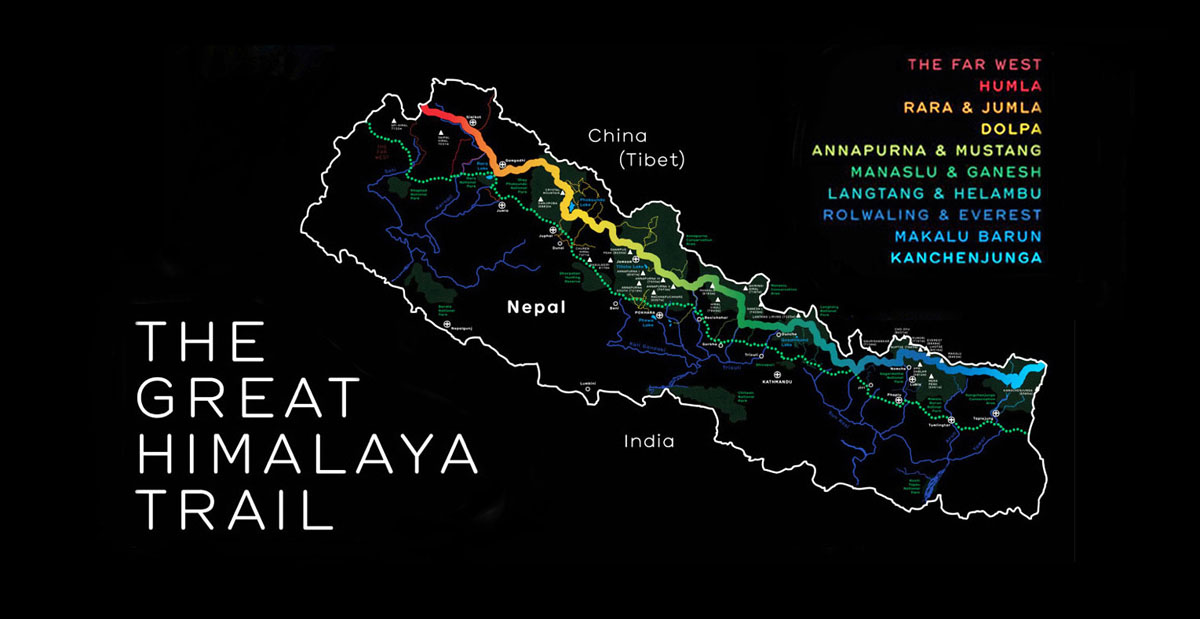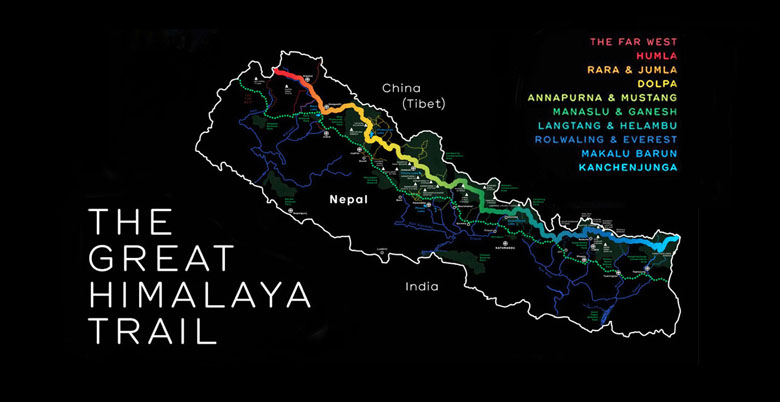

For those looking for the cutting edge of adventure travel, Nepal’s Great Himalaya Trail presents the opportunity of a lifetime. It’s one of the longest and highest footpaths on earth, and likely the most dramatic, traversing the entirety of Nepal from east to west in the shadows of the world’s highest peaks. No technical climbing is required—there are numerous high passes above 5,000 meters—but the 150-day plus journey is said to be far more difficult than climbing up any single mountain.
The Great Himalaya Trail is comprised of 10 varying sections from Kachenjunga on Nepal’s eastern border to Humla on its western border with Tibet. It passes from subtropical jungles to high altitude alpine ecosystems, through villages of Buddhists, Hindus, Sherpas, Tibetan refugees, Lhomis, and Shamans, among many others. One constant is the lack of development—these are not trekking paths but instead the existing network of primitive trade and pilgrimage trails that have been in use by local people for centuries. In fact, not one new trail was blazed.
To understand the context of the Great Himalaya Trail, the adventure pilgrimage to Nepal officially began in 1950 when the country opened its borders to the outside world for the first time. Early climbing pioneers, mostly from western countries, eagerly flocked to Kathmandu for the opportunity to face off against the world’s biggest mountains. That year Annapurna I was the first 8,000-meter peak to be summited, and in May of 1953 Edmund Hillary and Tenzig Norgay successfully climbed Mt. Everest (nobody knows who, if either, got there first, and the men forever remained silent on the topic).
Things in Nepal were different back then—Hillary’s massive group spent a treacherous month hiking from Kathmandu through the jungles and heat just to reach the Solu-Khumbu Region and Everest Base Camp. The Sherpa people only became “Sherpas” because they lived closest to the sacred mountain and were convinced to help on the expeditions. Even the famed Annapurna Circuit was, at one point, not a circuit at all but a basic path of commerce for local villagers.
By the 1960’s the idea was hatched that Nepal should be a haven for trekking too. What began as a trickle of trekkers gained momentum and the country soon garnered the reputation as the birthplace of adventure tourism. For many years, decades in fact, the Annapurna Circuit and Everest Base Camp treks dominated the spotlight. With the existence of these two lifetime treks into the heart of the Himalayas, and a relatively low number of people actually willing to travel to Nepal for weeks of mountain walking, there wasn’t pressure for anything else.
The slow deterioration of the Annapurna Circuit by encroaching roads may have been the straw that broke the camel’s back in forcing trekkers to rethink their options, or perhaps people finally realized that Nepal’s mountains have so much more to offer. In fact, Nepal always has had thousands of kilometers of trails through remote villages that carry a similar aura as its most famous treks.
In 2009 the Great Himalaya Trail (GHT) was born. It is still a very rough patchwork of local footpaths, but after five years of research, documentation, and mapping, the GHT was walked for the first time in 2008 and 2009 by a team led by Robin Boustead in 162 days. The first commercial trip ran from February through August of 2011 and was completed successfully in 157 days. Only a small handful of guiding companies market the GHT, and only two have completed the trail in its entirety.
Regardless of whether or not you walk the full length of the Great Himalaya Trail, it represents the biggest shift in how we think about trekking in Nepal since the concept was introduced here in the 1960’s. The two trails that have received almost all of the attention to date represent only a fraction of the Great Himalaya Trail, which in turn represents only a fraction of the trekking opportunities in Nepal. More, it is proposed to extend the Great Himalaya Trail more than 4,500 kilometers stretching through Pakistan, India, Nepal, Bhutan and Tibet in China. When and if the full trail comes to fruition, the Nepal section, now open and operational, will still stand out mightily as one of the world’s last great adventures.
More Information on the Great Himilaya Trail can be found at www.thegreathimalayatrail.org.
Starting and ending points: Kachenjunga on Nepal’s eastern border with India and Humla on its western border with Tibet
Total distance: 1,700 kilometers (1,056 miles)
Number of Sections: 10
Shortest Section: Langtang (18 days)
Longest Section: Makalu to Everest (34 days)
Time Required: Approximately 150 days for the entire GHT, but most hikers opt for shorter sections
When to go: The best months for trekking are September to November and March to May
Difficulty: Challenging
Accommodations: Basic mountain lodges (teahouses) and camping
World Expeditions has been the pioneers of the Great Himalaya Trail and is the only company that offers the full GHT. Shorter sections range from 18-34 days with the full traverse taking 152 days.
Swiss Nepal Family Trekking offers nine sections of the Great Himalaya Trail ranging from 26 to 36 days.
BackTrack, an Australian company, has begun marketing the GHT and currently offers the Dolpo (20 days) and Kachenjunga (27 days) sections.